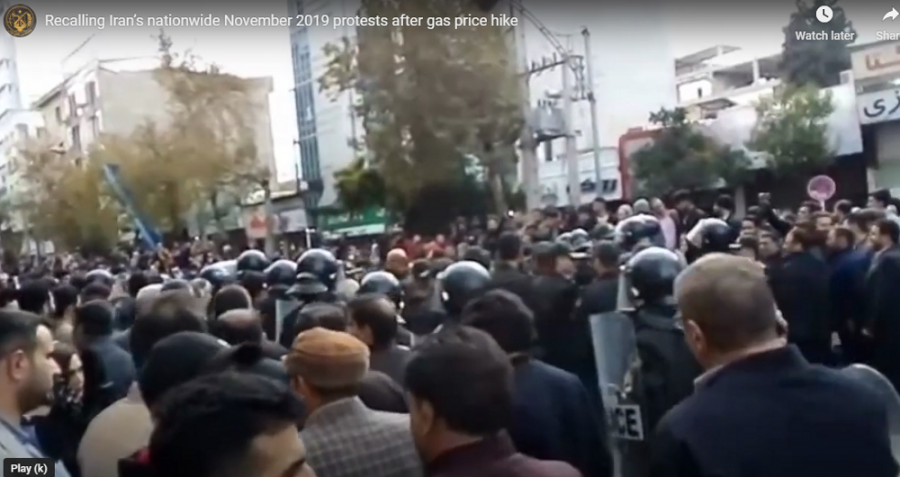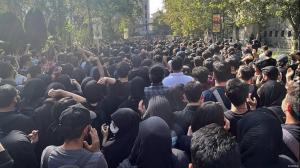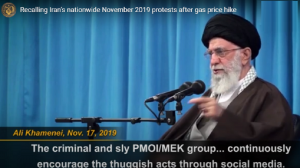
(Video) The legacy of the November 2019 uprising in Iran
A characteristic of this uprising was its organized nature and the cooperation of the people and rebellious youth to overcome the regime’s security forces.
PARIS, FRANCE, November 18, 2024 /EINPresswire.com/ -- The National Council of Resistance of Iran (NCRI) Foreign Affairs Committee in an article published that as Iran approaches the fifth anniversary of the November 2019 protests, the country finds itself gripped by a severe socio-economic crisis, intensified by Supreme Leader Ali Khamenei’s risky regional strategy.
Following the 2022 nationwide uprising, Khamenei reportedly initiated a regional war, aiming to deflect rising domestic grievances. Yet, a year later, facing high casualties among his proxy forces and a declining economy, Khamenei’s approach has left the regime vulnerable, its defenses strained both at home and abroad.
The current economic challenges have reignited concerns about protests similar to those in 2019 and 2022. Hossein Raghfar, an economist at Al-Zahra University, recently told Jamaran News, “We face the risk of protests like November 2019 and Fall 2022.
The events of November 2019 were a cumulative eruption of grievances and humiliations across Iran’s youth.” These remarks underscore the escalating frustrations amid severe economic strain, including rising prices, cuts to essential services, and widespread dissatisfaction.
In a significant move on November 12, Masoud Pezeshkian’s government announced that licensed entities could import high-grade gasoline at unsubsidized prices, a decision that analysts believe may soon drive further hikes in fuel costs.
While government spokesperson Fatemeh Mohajerani claimed the imports were “separate from the subsidized fuel distribution infrastructure,” she acknowledged severe mismatches in energy supply.
“The administration is committed to public health, reducing fuel oil consumption despite power outages, and addressing this imbalance,” Mohajerani said. Observers note that the government’s piecemeal announcements reflect an attempt to avoid a repeat of the 2019 uprising, sparked by a sudden gasoline price increase that spurred mass protests across the country.
In another recent statement, the Iranian regime’s president Massoud Pezeshkian commented on the untenable nature of subsidizing fuel. “It is unreasonable for the government to import gasoline at the free-market dollar rate and sell it at subsidized prices,” Pezeshkian stated, adding that the policy goes against expert recommendations. “A government unable to fund medicine, wheat, and pensions cannot afford to buy gasoline at 50,000 rials and sell it for 10,000.”
Iran’s growing list of crises now encompasses systematic corruption, political repression, environmental degradation, rampant inflation, and the dominance of the Islamic Revolutionary Guard Corps (IRGC) in nearly all sectors of the economy.
Additional grievances include a brain drain, a plummeting currency, devastating air and water pollution, deforestation, and widespread food and medical shortages. For many Iranians, the list has grown long, with many referring to these grievances as “80 million reasons” for change.
On the international front, tensions continue to rise following Germany’s recent decision to close all Iranian consulates in response to Iran’s execution of Jamshid Sharmahd, a German Iranian dual national.
Foreign Minister Annalena Baerbock announced that while the Iranian embassy would remain open, diplomatic relations had deteriorated sharply, and she urged the EU to add the IRGC to its list of terrorist organizations.
This move comes as Iran’s internal repression and human rights abuses draw greater scrutiny worldwide, with Germany’s move seen as an indicator of mounting European disapproval.
Adding to the regime’s woes, Iran’s currency hit a record low following the recent U.S. presidential election victory of Donald Trump. The IRGC’s Telegram channel quickly posted a video threatening Trump’s life, reigniting fears of U.S. backlash.
The threat reflects a deep-seated resentment stemming from Trump’s authorization of the 2019 killing of IRGC General Qassem Soleimani. The clerical regime is reportedly terrified of the potential reinstatement of the new U.S. administration’s “maximum pressure” policy, which could significantly worsen Iran’s economic turmoil and pave the way for more unrest.
Internally, Iranian officials have reportedly intensified efforts to prepare for Khamenei’s eventual succession, fearing that his death could trigger nationwide efforts to overthrow the regime. Speculation has intensified around Khamenei’s son, Mojtaba, as the likely successor, a move seen as a consolidation of power within the supreme leader’s inner circle.
Mojtaba Khamenei’s increased visibility suggests that the regime is moving to secure his position, with Abbas Palizdar, an influential figure, describing him as “well-equipped to implement necessary reforms.”
Despite such efforts, Khamenei and his administration appear aware of the fragility of their position. The regime’s attempts to soften the blow of economic policies through rumor and staged announcements, such as with fuel pricing, reveal lessons learned from the backlash in 2019.
The government has continually tested the public’s response before implementing price hikes or cuts to avoid widespread unrest. But as Raghfar and other analysts have warned, these measures may no longer be enough.
ronts, Khamenei now faces limited options and a restless population. The sentiment in the streets echoes a growing defiance, with chants of “Fight and we will fight back” reverberating across the nation.
Viewing its investment in Western appeasement policy slipping away, and with its proxy forces and regional strategy severely weakened, Khamenei finds himself confronting a younger generation angrier, more resilient, and led by the People’s Mojahedin Organization of Iran (PMOI/MEK)-led Resistance Units—poised to make this a defining moment for Iran.
Iran’s November 2019 uprising, which is marking its fifth anniversary, has characteristics that set it apart from other nationwide uprisings. Beginning on November 15 and lasting for a week, this uprising sent shockwaves throughout the regime.
The uprising began with the sudden state-imposed price hike on fuel and gasoline. The people of Iran, living under extreme poverty and fed up with decades of corruption and tyranny, poured into the streets to protest the regime’s destructive policies. The movement soon turned into a nationwide uprising.
As acknowledged by cleric Alireza Adyani, representative of regime supreme leader Ali Khamenei and head of the regime’s ideological and political security forces, the intensity and scope of the uprising extended to 165 cities across 25 provinces, generating “instability” or rather, uprisings at 900 points nationwide in just one day. The main centers of the uprising were Shahriar, Shahr-e Qods, Shiraz, Behbahan, Isfahan, and Tehran.
A defining aspect of this major uprising was the explosive anger of the people, fueling widespread fires aimed at destroying regime-affiliated institutions. Furious citizens and rebellious youths attacked and set fire to banks, gas stations, police stations, governorate offices, district offices, police kiosks, security vehicles and motorcycles, Basij and IRGC bases, large stores owned by the Revolutionary Guards, seminaries, Friday prayer leaders, ATMs, aid committee funds, and other regime facilities.
Contrary to the regime’s demonizing propaganda, it is noteworthy that the protestors did not harm any places or belongings of ordinary citizens, and their targets were regime buildings and assets.
Another characteristic of this uprising was its organized nature and the cooperation of the people and rebellious youth to overcome the regime’s brutal security forces.
Mojtaba Zonnour, the head of the Security Commission in the Majlis (parliament), said in a government television interview on November 24 that year:
“They threw 50 tear gas grenades at a Basij base to capture it.
They had received training, with teams assigned specific tasks. Using special materials, they could crack walls or columns on impact, disabling or destroying structures. Teams were assigned to break locks; one team would complete its task, and the next team would proceed with the following steps.”
To quash an uprising that threatened the regime’s foundation, Khamenei ordered brutal force, resulting in his agents killing at least 1,500 people with bullets. They even shot at young people who sought refuge in the marshlands with heavy machine guns. Additionally, as reported by Michelle Bachelet, UN High Commissioner for Human Rights, at least 7,000 people were arrested in 28 provinces following the start of the protests.
Young people and women played a significant role in the uprising. The book “Silent Fire,” published by an expert research institution named “Rahman,” concludes based on various reports and data that the majority of participants, as well as those arrested or killed in the November 2019 uprising, were underprivileged young people.
“The youth movement is where awareness and deprivation converge—youth are aware of the deprivation in society, they suffer from it and seize every opportunity to express their dissent. In the November protests, these young people played a prominent role. It could be said that they were the driving force behind these protests” (Overview of the November 2019 Protests, Rahman Institute, June 2020).
Another key feature was the emergence of women as a powerful force for change, tapping into their historical potential. In many cities, the uprising progressed with the pioneering role, courage, and audacity of women.
This role was so conspicuous in breaking through obstacles that the oppressive regime had no choice but to acknowledge the “leadership role of women.” This did not go unnoticed by even the IRGC’s own news agency:
“The prominent role of women in leading the recent unrest is noticeable. In several areas, especially around Tehran, women aged 30 to 35 seem to play a specific role in leading the protests. According to observations by Sobhe-No’s reporter, these women, dressed uniformly, each take on a distinct task one films the protests, other blocks vehicles, and another encourages people to join the protests. Why women have become key players in the recent protests is itself a question worth asking” (Fars News Agency, November 20, 2019).
Yes, such a presence does raise questions. What is the answer?
A Resistance movement with a strategy
Iran’s democratic movement, fortified by an organized Resistance and a clear alternative to the mullahs’ regime, has kept the people’s struggle for freedom on the right path. Any event in Iran directed towards the regime’s overthrow will inevitably proceed along a path paved by this Resistance, with guiding lights marking the way. The November 2019 uprising stands as the clearest testament to this strategy.
On June 20, 1981, hundreds of thousands of PMOI supporters and members held protests across Iran, marking the beginning of the all-out resistance against the mullahs’ regime.
In the decades since it was become clear that the only solution to bringing freedom in Iran is the path of the Resistance. The November 2019 uprising was the fruit of a 40-year-old tree, whose seeds were planted by the PMOI in 1981 and nourished with blood and suffering of more than 120,000 members and supporters of the organization who laid down their lives for freedom.
The legacy of the November uprising will persist until a democratic republic rises from the ruins of theocratic despotism.
If you wish to receive the NCRI weekly Newsletter, please use the following link to subscribe: https://bit.ly/3SMgEla.
Shahin Gobadi
NCRI
+33 6 61 65 32 31
email us here
Contrary to the regime’s demonizing propaganda, it is noteworthy that the protestors did not harm any places or belongings of ordinary citizens .
Distribution channels: Human Rights, International Organizations, Politics, U.S. Politics, World & Regional
Legal Disclaimer:
EIN Presswire provides this news content "as is" without warranty of any kind. We do not accept any responsibility or liability for the accuracy, content, images, videos, licenses, completeness, legality, or reliability of the information contained in this article. If you have any complaints or copyright issues related to this article, kindly contact the author above.
Submit your press release




